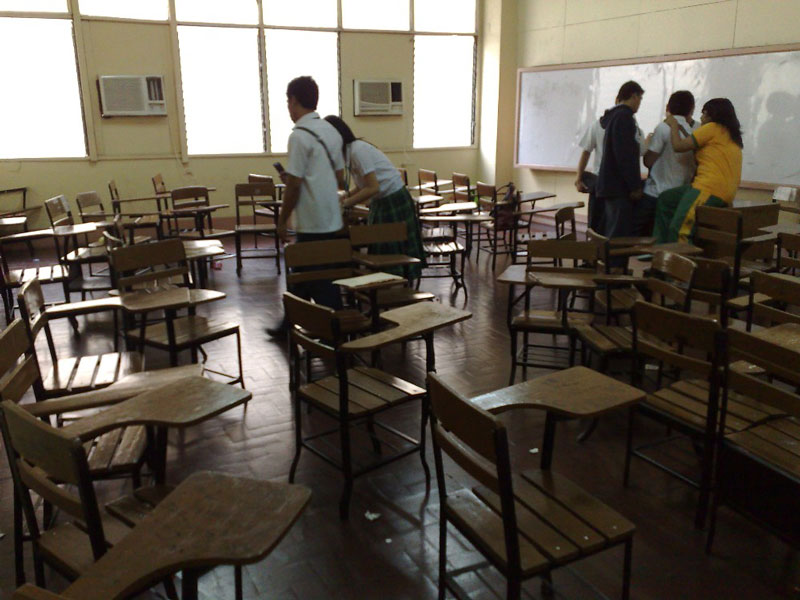The State shall give priority to education and “protect and promote the right of all citizens to quality education at all levels,” as the Constitution states. With this end, the government shall “establish, maintain and support a complete, adequate and integrated system of education relevant to the needs of the people and society.”
At first glance, our academic institutions are doing their tasks of educating the youth and developing their intellect. But a closer look at the reality would show that our schools, particularly the colleges and universities, experience the same challenges and threats present in a larger society.
Identifying the Problem
Schools face a wide range of threats. Criminal activities, such as illegal drugs, kidnappings, physical injuries, extortion, and theft are some of them. Fraternity hazing can sometimes lead to tragic consequences. Gangs create trouble and inflict harm to the students.
Terrorism is shown in the form of bomb threats and detonation of improvised explosive devices. Attacks on cybernetic security disable computer networks and communication facilities.
Man-made disasters like fire caused by accidents or arson,including faulty wirings. Meanwhile, natural disasters include typhoons and earthquakes cause heavy toll on many lives and properties. At the same time, environmental degradation may result to landslides and flash floods.
Health concerns brought by the spread of the influenza A (H1N1) virus lead to panic, suspension of classes and sometimes temporary school closure.
Certainly, educational institutions in the country agree that “campus threats undermine the rule of law, engender violence and in some instances impunity, exacerbate conflict and represent a serious danger to the safety of the members of the school community.”
Little Steps to Change
Campus security is an ever-increasing concern. The many threats to safety and welfare of the school community expose students, faculty, administrative personnel and support staff to several risks.
Campus security management is mandated under B.P. 232, which says it is the school’s responsibility to maintain a safe and secure campus environment that is conducive for learning. This endeavor is a struggle that cannot be waged alone. It requires marshaling the energies of all the members of the academic community as campus security threats come from both internal and external sources.
Currently, there are professional school security practitioners who have taken decisive steps to confront the problem.School security organizations give priority to eliminate the lurking threats in many campuses. These organizations are working towards drafting a common stand based on shared responsibility and collaboration to serve the school community.
The adoption of a Campus Security Act or the “Declaration of Policies on Campus Security in the Philippines” in the future through a congressional action should provide the impetus needed for strengthening campus security.
Welcoming New Approaches
Today, we face different threats. We have no choice but to face them upfront. As globalization has generated changes affecting us all, the multiplicity of threats compels school campuses to proactively confront new challenges and take appropriate actions.
Special attention is now underway with an increasing focus on the new concepts of school security. The debate is not merely academic. On the contrary, school administrators must take practical decisions to maintain a peaceful environment in the campus. Although we should respect individual freedoms and rights, we must also protect the welfare of the school community. It has evolved from a conventional approach to security to a broader concept that encompasses new threats.
Campus security management needs to be multidimensional and comprehensive. It should reinforce systems to overcome vulnerabilities. School management priorities vary as each school is affected in different ways and degrees,both by traditional and emerging threats.
Stakeholders’ Coordination
The national government, through the Department of Education (DepEd) and the Commission on Higher Education (CHED), has called for an effective cooperation and coordination among schools and stakeholders to deal with the existing and emerging threats.
Security practitioners cannot overemphasize the value of vigilance among the stakeholders in many educational institutions. Those tasked with ensuring campus security should also be committed to their jobs and totally dedicated to the well-being and safety of the students, teachers and other school staff.
All schools should fully comply with the provisions of B.P. 232 if they want to be safe and secure. An effective campus security management system should include new modes of cooperation when dealing with new threats.
Schools should further improve existing control mechanisms, adopt appropriate measures in specific threats, and encourage the exchange of experiences on campus security with other educational institutions. They should also avail of training opportunities offered by local, national and international safety organizations.
Campus security managers and campus security management teams must demonstrate zeal and utmost dedication in delivering the successful implementation of campus security programs. School administrators should backstop their efforts with the necessary resources and logistics, and take the lead in unifying the entire school community to achieve a sound, rational and workable program for campus security. After all, security should be the concern of everyone. •







One response to “Managing Campus Security: Everybody’s Concern”
What is the provision on BP 232? Thank you.